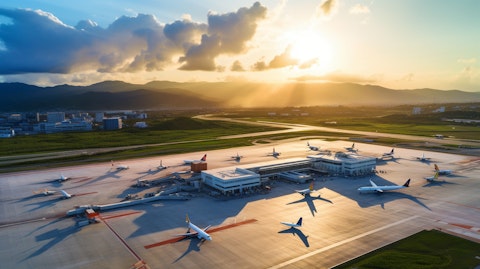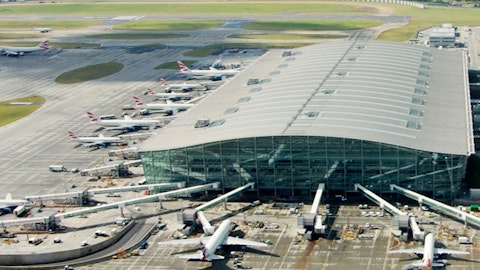Grupo Aeroportuario del Sureste, S. A. B. de C. V. (NYSE:ASR) Q4 2023 Earnings Call Transcript February 27, 2024
Grupo Aeroportuario del Sureste, S. A. B. de C. V. isn’t one of the 30 most popular stocks among hedge funds at the end of the third quarter (see the details here).
Operator: Good day, ladies and gentlemen, and welcome to ASUR’s Fourth Quarter 2023 Results Conference Call. My name is Doug, and I will be your operator. At this time all participants are in a listen-only mode. [Operator Instructions] As a reminder, today’s call is being recorded. Now, I’d like to turn the call over to Mr. Adolfo Castro, Chief Executive Officer. Please go ahead, sir.
Adolfo Castro : Thank you, Doug, and good morning, everyone. Before I begin discussing our results, let me remind you that certain statements made during this call may constitute forward-looking statements, which are based on current management expectations and beliefs and are subject to several risks and uncertainties that could cause actual results to differ materially, including factors that may be beyond our company’s control. As usual, additional details about our quarterly results can be found in our press release, which was issued yesterday after market closed and is available on our website, Investor Relations sector. Following my presentation, I will be available for Q&A. Before getting into a discussion of the quarterly results, let me start today’s call with a recap of the recent developments.
A significant milestone for the quarter was December 2023, approval of the 2024-2028 master development plan for our Mexican Airports. This approval occurred under the government’s new regulations and increase of the concession fee to 9% from the 5% of total gross revenues starting from January 3 of this year. Some key highlights of the new MDP include. The efficiency factor used to annually adjust the maximum tariffs increase from 0.7% to 0.8% in the prior MDP. The methodology to calculate the discount rate is now based on weighted average cost of capital compared to cost of equity before. The new MDP 2024-2028 also calls for a total CapEx commitment of MXN 28.5 billion measure in December 2022 tariffs for the five year period. Of these five year CapEx, 75% equivalent to MXN 21 billion or approximately $1.4 billion, will be invested at Cancun Airport, 70% of which will be allocated to expansion works.
Key projects include the second phase of the expansion of the International Terminal 4, which includes additional four boarding gates that have been delayed due to the pandemic, a new road connecting the terminals to the major trains. We also plan to rebuild and expand Terminal 1 as well to expand airport roads. These investments support a new growth phase for Cancun in the years ahead. The remaining 25% will be allocated across our eight smaller airports in Mexico, with approximately 7% allocated to Oaxaca, where we plan to reconstruct and expand the terminal building. Finally, minor terminal expansions at four of the other airports. For 2024, we plan to invest a total of MXN 3.5 billion, 73% of which will be invested in Cancun. Also note that, the new MDP rebalances the impact of the recent opening of the Tulum Airport.
We ended the year with a 98.2% maximum tariff compliance, which includes the effect of the 10% passenger fee discount granted during November and December as a result of the agreement reached with the Mexican government. During the quarter, we conclude negotiations with our strategic partner, ITA by Twitch. Starting January 2024, the technical assistance fee has been reduced to 2.5% from 5% of the EBITDA generated by Mexican operations. On December 21 of last year, the Supreme Court of Justice rejected the appeal filed by the Airport International Bavaro against judgment that suspended the permit to start construction previously issued by the Civil Aviation Institute. More recently, on January the 5, the president of Dominican Republic issued a decree cancelling the previous decree issued by the previous President, which had approved the establishment of Bavaro International Airport.
On January 19, an appeal for consideration review was brought before the Constitutional Court against the Supreme Court of Justice, notified on December last year. On the sustainability front, during the fourth quarter, we completed the installation of solar panels in the airports of Tapachula and Huatulco. We will generate the combined output of 1.5 million kilowatt hours in the first year of operation. These in addition to the solar panel projects already completed in the airports of Cancun, Medellin and Oaxaca. We generated a total of nearly 632,000 kilowatt hours of solar energy during the fourth quarter. As part of our continued sustainability efforts, our airports in Mexico renewed their certification at Level 2 under the Airport Carbon Accreditation program.
This program is organized by the Airport Council International to provide a framework for measuring, reducing and compensating carbon emissions. Also in the fourth quarter, we became signatories of the science-based targets initiative, with the goal a roadmap to achieve zero emissions by 2050. Among the community projects, ASUR involved in — we provided support to promote ecological tourism activities in the Malian speaking rural communities in the northern region of the state of Yucatan. Locals are provided with training and equipment to supplement their income from traditional fishing activities. By close of 2023, 49 tourist sites with approximately 100 economic dependents were provided with training and we intend to scale up these activities to additional communities in 2024.
We plan to publish our 2023 Annual Sustainability Report next month and encourage you to read it. Let’s review ASUR’s operational and financial performance for the quarter. As usual, all comparison discussed will be year [Technical Difficulty].

Operator: Mr. Castro, are you there? One moment, ladies and gentlemen. It appears that we have lost Mr. Castro. I’m going to try and reconnect. Rejoining Adolfo Castro.
Adolfo Castro : Thank you, Doug. Let’s review ASUR’s operational and financial performance for the quarter. As usual, all comparisons this quarter will be year-on-year unless specified otherwise. Starting with traffic, we saw nearly 18 million passengers travel across our airport network, the highest level for a fourth quarter. Even at the growth rate, this accelerated to 1%. This brought total traffic for the year to a total record of high over 70 million passengers, with an annual increase of 10% in Mexico, 18% in Puerto Rico and partially offset by a decline of nearly 10% in Colombia. Looking at the quarterly performance by region, Puerto Rico delivered the strongest growth, with traffic up nearly 13%, driven by a solid performance in both domestic and international traffic.
In Mexico, traffic increased 4% supported by a low single-digit growth in domestic and international passengers. Traffic driven from the United States and Canada remain the key growth engine, while domestic traffic is experiencing the initial effects of Pratt & Whitney engine problems. Also, not working as from January 8, the Mexico City airport reduced its air traffic movements per hour to 43 from 52. This airport accounted for 45% of the domestic passenger traffic in 2023, and those is also expected to negatively impact domestic traffic this year. Additionally, the strength of the Mexican peso has been impacting the results for the quarter. Lastly, Colombia posted a 13% decline in traffic and domestic travel remained impacted by the suspension of 2 local airlines in February of last year, partially offset by a 2% increase in international travel.
Recall that, these two airlines accounted for 20% of all traffic in Colombia in 2022. Avianca and Latam Airlines have been absorbing some of that traffic starting this March we expect to start seeing a recovery in traffic growing in Colombia. Now turning to the P&L. As a reminder, all reference to revenues and costs exclude construction and cost revenues. Total revenues increased nearly 5% to just over MXN 6 billion in the fourth quarter, as growth in Mexico and Colombia was partially offset by weaker performance in Puerto Rico, due to the exchange rate. Mexico, which accounted for 74% of revenues, posted a 6% increase in the top line driven by need to high single-digit growth with aeronautical services up 5% and non-aeronautical services increasing 7%, mainly reflecting higher passenger traffic.
Puerto Rico, which accounted for 14% of total revenues, reported a 1% decline in revenues mainly due to the 4% decrease in aeronautical revenues, partially offset by a 2% increase in commercial revenues. Lastly, Colombia, which represented 11% of revenues, posted a mid-single-digit top line increase, supported by the growth of 3% in aeronautical revenues and 8% in non-aeronautical services, reflecting our sustained focus on expanding our commercial offering across our airport network. Commercial revenues were up 70%, above the 1% increase in passenger traffic, driven by the high single-digit increases in Mexico and Colombia both up 8%, together with a 3% growth in Puerto Rico. On a per passenger basis, commercial revenues reached MXN 119, up 6% on a consolidated basis and for country in Mexico and Colombia, commercial revenues per passenger increased 4% and 20% respectively, while Puerto Rico decreased nearly 9%.
In local currency, Puerto Rico and Colombia posted increases in commercial revenues of 15.2% and 1.2% and in commercial revenues per passenger of approximately 2.4% and 19.1% respectively. These increases partially reflect our initiatives to continue enhancing passenger travel experience. These include the opening of 65 new commercial spaces across our airport network during the last 12 months. Of these, 17 were opened in Mexico, 4 in Puerto Rico and 44 in Colombia. Comparable consolidated EBITDA, excluding other non-recurring income in the year-ago quarter, increased 1% to MXN 4.1 billion. Recall that the fourth quarter 2022 results included a one-time our income of MXN 300 million in Puerto Rico in connection with a federal judgment in connection with the right to charge a fee for each gallon of aviation fuel dispatched at the airport between 2013 and 2021.
Mexico remains the main driver of profitability, with EBITDA up 5% followed by Puerto Rico with 1% comparable increase. By contrast, Colombia posted a 23% drop in EBITDA, impacted by disrupted passenger traffic. In turn, comparable adjusted EBITDA margin, which excludes construction as well as the other non-recurring income in the fourth quarter 2022, was nearly 68% versus a comparable of 70% margin into fourth quarter 2022. Last, moving on to the balance sheet, we close the year with a strong cash position of nearly MXN 16 billion and a negative leverage ratio of 0.2% — 0.2x. Wrapping up, we’ll finish 2023 on a very solid note, which we believe put us on a solid path going into 2024 and 2025. Our long-term opportunities supported by our ongoing investments to further enhance the travel experience of passenger traveling to our airports.
Continue to expand our commercial offerings and extend capacity to support future growth, while maintaining a balanced use of cash. This ends my presentation. Doug, please open the floor for questions.
See also 15 Countries with Most Car Accidents per Capita and 20 Countries With the Longest Coastlines in the World.
Q&A Session
Follow Grupo Aeroportuario Del Sur S A (NYSE:ASR)
Follow Grupo Aeroportuario Del Sur S A (NYSE:ASR)
Operator: [Operator Instructions] Our first question comes from the line of Juan Ponce with Bradesco BBI.
Juan Ponce: So I have two questions, one on traffic and the other one on expenses. On traffic, how much of an impact are you seeing in domestic traffic from this Pratt & Whitney inspection schedule? We just saw Volaris say that they secured additional capacity to compensate for the impact. So, what are you seeing on the ground? How much — if you can quantify the impact that you’re seeing for domestic traffic in Mexico that would be great. And then my second question would be on operating expenses. We did see them go up more than expected this quarter. I just wanted to get some more color on where you’re seeing the margin for this year?
Adolfo Castro : Well in the case of Pratt & Whitney, as I said in the initial remarks, we are seeing weaker passenger traffic for the domestic side. How can we measure this? It’s very clear when we see upward seats and when we see the increase in the load factor. It’s very clear for me that Volaris has increased their load factor and they also have increased their rates. And of course, this is creating less amount of passengers in the case of domestic. That is not the case of Viva. So in the case of Viva, they were able to increase the average seats and also the increase of passenger traffic, but they were not able to offset the decrease of the Volaris. The other thing that is extremely important from now on from January 8 is what I just mentioned, in the case of Mexico City.
The case of Mexico City reducing their air traffic limits per hour from 52 to 43. And of course, that is having also an impact on our passenger traffic. These both things I believe will be seen during the first quarter of this year. In terms of expenses, well the main effect — the main increase in expenses was coming from Colombia. And in that sense, it was due to increasing salaries. We adjusted salaries, things that we were not doing or that we stopped doing because of the pandemic situation. So that is why the increasing in the case of Colombia is so strong. But of course, together with the passenger traffic decreased, the results in Colombia doesn’t look well, what I hope is that this year, with the end of this situation with the two airlines, as from March, we will see a different situation.
Operator: Our next question comes from the line of Pablo Monsivais with Barclays.
Pablo Monsivais: I have two on my side. The first one is if you can provide the amounts on each project that you have in Cancun and the Terminal 1 and the additional gates? And also my second question, I heard you say something about Dominican Republic, but if you can tell us again what’s the update there?
Adolfo Castro : Well, in the case of the project as I said MXN 21 billion is Cancun and 70% of that as expansion projects. Those expansion projects are the site of Terminal 4, which will add the four additional gates that were not completed due to COVID. If you go back to March 2021, the delaying CapEx or the performing CapEx was nearly MXN 2 billion. Also, in the case of Cancun, we will reconstruct and expand Terminal 1. Those are the three major projects in terms of terminal expansions plus the additional connection to the major train and the roads to the airport. In the case of the airports in Dominican Republic, the situation is that there was a legal process that stopped the beginning of the construction. And that has been confirmed in December 16 last year.
Also, on top of that the President issued a decree cancelling the previous decree that was issued by the previous President authorizing the airport. We have presented legal recourses for both things. And we will have to wait and see what is the outcome of these legal processes. But it’s clear to me that the project has been put on hold at least for the next 12 months.
Operator: Our next question comes from the line of Anton Mortenkotter with GBM.
Anton Mortenkotter: Congrats on your results. I just have a quick one. Any thoughts about capital allocation, maybe an extraordinary dividend or maybe some buybacks now, also considering the potential savings from the reduction in the technical assistance?
Adolfo Castro : Well, it’s two different things. One is the case of the capital allocation. We will review this once we have completed — we have finished the year and we will review the results and the current situation, the future CapEx tax and all of that and we will make our proposal to the Board of Directors that we’ll have meeting the first week of March, and then to the shareholders assembly. The case of the technical assistance fee that it was in accordance of what we received from the Mexican government during the negotiation process. So basically, we were able to negotiate with ITA the adjustment in the fee by 50% reduction.
Anton Mortenkotter: Sorry, just to know, see if I hear you right. So the reduction in the technical assistance fee was something that was also discussed with the Mexican authorities and incorporated in the MDP?
Adolfo Castro : Well, the Mexican authorities in their new rules, they’ve reflected that adoption in the recognition of the technical assistance and that is why we have to negotiate with ITA.
Operator: Our next question comes from the line of Andressa Varotto with UBS.
Andressa Varotto: I have two questions on my side. The first one is on how is the implementation of the new maximum tariff going so far? If you can provide maybe a timeline that you are expecting to reach the maximum tariff. And I have one question on Colombia, where we saw a passenger drop but an expansion in both aeronautical tariffs and non-aeronautical revenue per passenger. So, just wanted to know, what is driving that and also if the strong cost expansion in Colombia in the quarter, if it includes any non-recurring events?
Adolfo Castro : Okay. In the case of the new maximum rate increases that we saw from the OMDP. We have already started the process for that. It will take more or less four months, so I do believe that from the month of April, the new increase in tariffs will be in place. So during the first quarter, you will see no increases. And the increases will come as from April. In the case of Colombia, no, we do not have any non-recurring. It is important to see Colombian numbers in Colombian pesos, and then you will be able to understand better the situation that is there. During the quarter, the Colombian peso appreciated against the Mexican peso and that was the first quarter over the last couple of years. So, if we see what is happening there in Colombian pesos, let me go into the case of the passenger.
The commercial revenue of the passenger, as I said before, in Colombian pesos the increase was really important during the quarter. So, I will recommend you to make the analysis in a comparable basis, so excluding the FX.
Operator: Our next question comes from the line of Isabela Salazar with GBM.
Isabela Salazar: Regarding the technical assistance fee reduction, I understand that this is a very positive action. However, I was wondering if you could give us more color behind the rationale for the reduction. Because I would like to understand if it will result in some costs moving to the upward level or if it will be a direct saving.
Adolfo Castro : First, it depends on how you measure this. If you see the new maximum rates, well, those are the ones that are going to be in places from this year. If your forecast was considering for this year 5%, then you can place a 2.5% instead of the 5% and then it will be for you a reduction or a saving.
Operator: Our next question comes from the line of Gabriel Himelfarb with Scotiabank.
Gabriel Himelfarb : Just a quick question about the dividend policy. Are you planning to propose a higher dividend or keep the dividend stable? I know it’s up to the Board, but what’s the strategy the company is seeking for the dividend for this year?
Adolfo Castro : Well, you know that we do not have a dividend policy in writing that we review that thing every single year. And once I finish with you, I will start referring that proposal for the Board and then to the shareholders assembly, as I said before. Our next Board of Directors will be the first week of March. So, I do believe that the first week of March you will figure out what I have proposed and what they have accepted.
Operator: [Operator Instructions] Our next question comes from the line of Jay Singh with Citibank.
Jay Singh: I’m just Jay Singh calling in from Stephen Trent’s Group. I just want to ask two questions on my end. First one is, what are you seeing on tourism bookings to southeastern Mexico? And my other one is, should the authorities block the airport project in the DR? Would ASUR be looking at any other overseas investments? And what seems to be going wrong with the process right now?
Adolfo Castro : Could you repeat your second question?
Jay Singh: Sure. So should the deal or the airport project in the DR get blocked? Would ASUR be considering any other overseas investments? And if so, what seems to be going wrong with the process right now with the Dominican Republic?
Adolfo Castro : Let me go first with the bookings. In the case of bookings, as I said in my initial remarks, we are seeing very good bookings coming from the U.S. and Canada. It’s not the case of domestic with the problems that we are having with the government present with me in the case of Mexico City Airport. Just to say that during the month of January, we lost in terms of domestic traffic to and from Mexico City around 100,000. So that will have an impact. These 100,000 are not willing to go to Santa Lucia. Yes, Santa Lucia is growing, but not absorbing all of these passengers. In the case of the Dominican Republic, as I said before, until we get the final rulings on these legal procedures we have there, we will not be able to start the construction of the airport. My expectation is that all of these at least will last the whole year.
Operator: There are no further questions in the queue. I’d like to hand the call back to Mr. Castro for closing remarks.
Adolfo Castro : Thank you, Doug, and thank you all of you again for joining us today in this fourth quarter 2023 conference call. On behalf of ASUR, we wish you a good day and goodbye. Now you may disconnect.
Operator: Ladies and gentlemen, this does conclude today’s teleconference. Thank you for your participation. You may disconnect your lines at this time and have a wonderful day.




